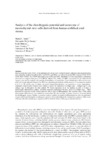Analysis of the chondrogenic potential and secretome of mesenchymal stem cells derived from human umbilical cord stroma

Ver/
Use este enlace para citar
http://hdl.handle.net/2183/16701Coleccións
- Investigación (FCS) [1293]
Metadatos
Mostrar o rexistro completo do ítemTítulo
Analysis of the chondrogenic potential and secretome of mesenchymal stem cells derived from human umbilical cord stromaAutor(es)
Data
2011-06-28Cita bibliográfica
Arufe MC, De la Fuente A, Mateos J, Fuentes I, De Toro FJ, Blanco FJ. Analysis of the chondrogenic potential and secretome of mesenchymal stem cells derived from human umbilical cord stroma. Stem Cells Dev. 2011 Jul;20(7):1199-212.
Resumo
[Abstract] Mesenchymal stem cells (MSCs) from umbilical cord stroma were isolated by plastic adherence and characterized by flow cytometry, looking for cells positive for OCT3/4 and SSEA-4 as well as the classic MSC markers CD44, CD73, CD90, Ki67, CD105, and CD106 and negative for CD34 and CD45. Quantitative reverse transcriptase–polymerase chain reaction analysis of the genes ALP, MEF2C, MyoD, LPL, FAB4, and AMP, characteristic for the differentiated lineages, were used to evaluate early and late differentiation of 3 germ lines. Direct chondrogenic differentiation was achieved through spheroid formation by MSCs in a chondrogenic medium and the presence of chondrogenic markers at 4, 7, 14, 28, and 46 days of culture was tested. Immunohistochemistry and quantitative reverse transcriptase–polymerase chain reaction analyses were utilized to assess the expression of collagen type I, collagen type II, and collagen type X throughout the time studied. We found expression of all the markers as early as 4 days of chondrogenic differentiation culture, with their expression increasing with time, except for collagen type I, which decreased in expression in the formed spheroids after 4 days of differentiation. The signaling role of Wnt during chondrogenic differentiation was studied by western blot. We observed that β-catenin expression decreased during the chondrogenic process. Further, a secretome study to validate our model of differentiation in vitro was performed on spheroids formed during the chondrogenesis process. Our results indicate the multipotential capacity of this source of human cells; their chondrogenic capacity could be useful for future cell therapy in articular diseases.
Versión do editor
Dereitos
Final publication is avaliable from Mary Ann Liebert, Inc., publishers web page.





